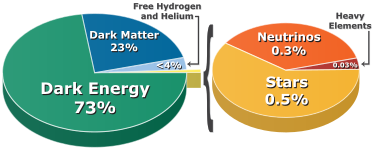::Dark Matter::
Dark matter
Main article: Dark matter
Chart shows the proportion of different components of the universe – about 95% is dark matter and dark energy.
During the 1970s and the 1980s, various observations showed that there is not sufficient visible matter in the universe to account for the apparent strength of gravitational forces within and between galaxies. This led to the idea that up to 90% of the matter in the universe is dark matter that does not emit light or interact with normal baryonic matter. In addition, the assumption that the universe is mostly normal matter led to predictions that were strongly inconsistent with observations. In particular, the universe today is far more lumpy and contains far less deuterium than can be accounted for without dark matter. While dark matter has always been controversial, it is inferred by various observations: the anisotropies in the CMB, galaxy cluster velocity dispersions, large-scale structure distributions, gravitational lensing studies, and X-ray measurements of galaxy clusters.
Indirect evidence for dark matter comes from its gravitational influence on other matter, as no dark matter particles have been observed in laboratories. Many particle physics candidates for dark matter have been proposed, and several projects to detect them directly are underway.
Additionally, there are outstanding problems associated with the currently favored cold dark matter model which include the dwarf galaxy problemand the cuspy halo problem.Alternative theories have been proposed that do not require a large amount of undetected matter, but instead modify the laws of gravity established by Newton and Einstein; yet no alternative theory has been as successful as the cold dark matter proposal in explaining all extant observations.





This comment has been removed by the author.
ReplyDelete